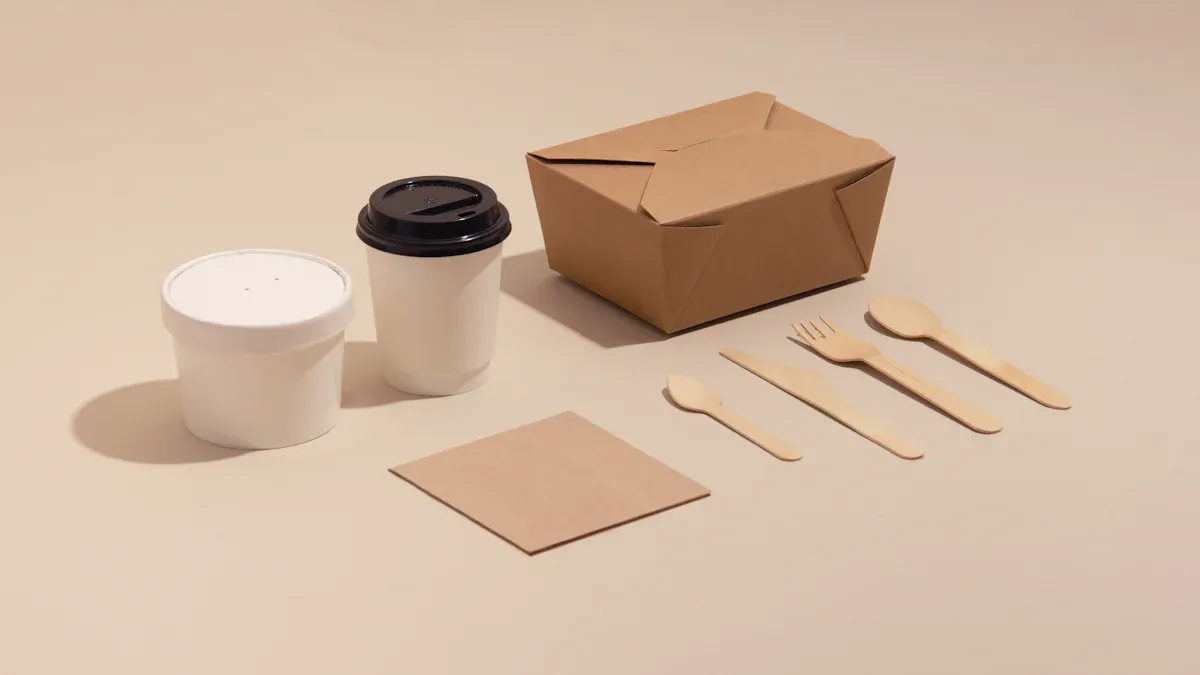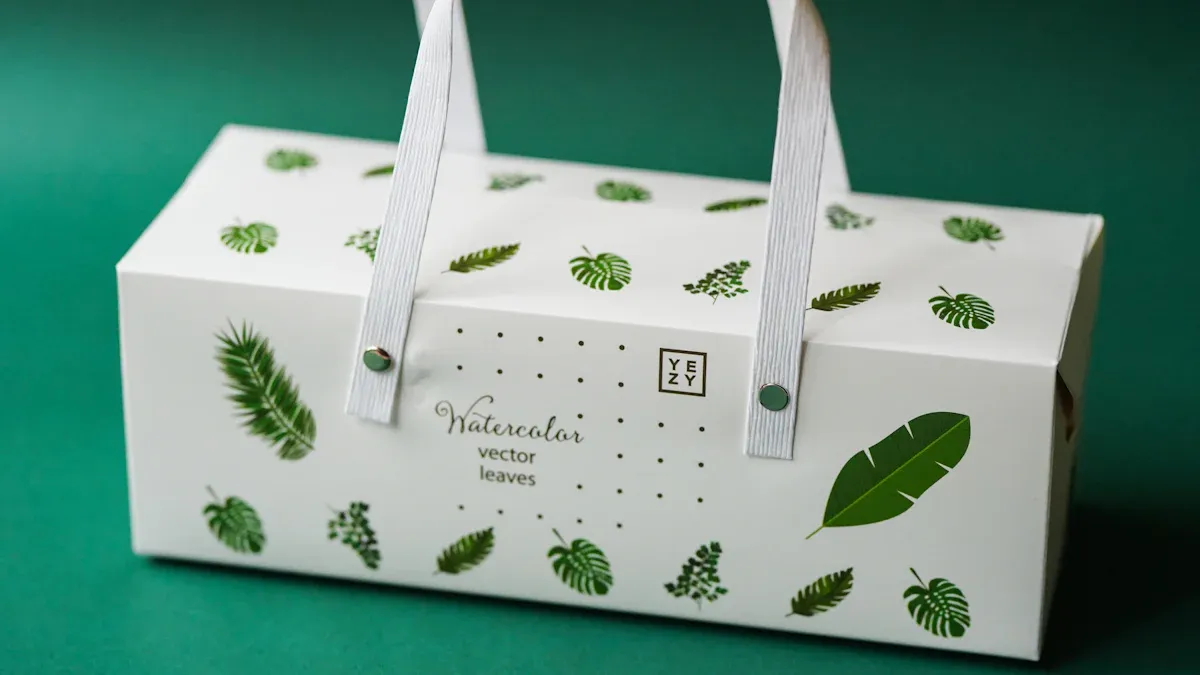
Food grade paper board has emerged as a cornerstone of sustainable packaging. Its eco-friendly properties, such as recyclability and biodegradability, make it a top choice for reducing environmental harm. In 2018, recycling rates for paper and paperboard reached 68.2%, diverting 46 million tons of waste from landfills. This effort reduced municipal solid waste by over 155 million metric tons of CO2 equivalent, similar to removing 33 million cars from the road annually. With products like ivory board paper food grade and food grade cardstock, businesses can meet consumer expectations while minimizing their ecological footprint. The market for sustainable packaging, including normal food-grade board solutions, is expected to grow from $272.93 billion in 2023 to $448.53 billion by 2030, with a CAGR of 7.6%. These advancements underscore the pivotal role of food grade paper board in driving a greener future.
Environmental Benefits of Food-Grade Paper Board

Recyclability and Circular Economy
Food-grade paper board plays a vital role in advancing the circular economy. Its recyclability ensures that packaging materials can be reused multiple times, reducing the need for virgin resources. This process minimizes waste generation and supports sustainable resource management. A study analyzing consumer preferences highlights the environmental advantages of paper-based packaging.
| Environmental Category | Paper-based Packaging Preference |
|---|---|
| Category 1 | 10 |
| Category 2 | 12 |
| Category 3 | 16 |
These figures demonstrate the growing inclination toward recyclable materials, underscoring the importance of food-grade paper board in fostering a sustainable future.
Biodegradability and Compostability
Unlike plastic packaging, food-grade paper board decomposes naturally, leaving no harmful residues. Its biodegradable properties make it an ideal choice for reducing environmental pollution. Compostable variants of this material further enhance its eco-friendly appeal. When disposed of in composting facilities, food-grade paper board contributes to nutrient-rich soil, promoting agricultural sustainability. This dual benefit of biodegradability and compostability positions it as a superior alternative to non-renewable packaging solutions.
Reduced Carbon Footprint
Switching to food-grade paper board significantly lowers carbon emissions throughout its lifecycle. Studies reveal that transitioning from solid bleached board (SBB) to Metsä Board folding boxboard reduces the carbon footprint by over 50%. Replacing white lined chipboard (WLC) with the same product achieves reductions exceeding 60%. These findings, verified by the IVL Swedish Environmental Research Institute, highlight the material’s potential to mitigate climate change. By adopting food-grade paper board, businesses can align their operations with global sustainability goals while meeting consumer demands for eco-conscious products.
Food-Grade Paper Board in the Packaging Industry
Applications in Food and Beverage Packaging
Food-grade paper board has become a preferred material for packaging in the food and beverage sector. Its versatility allows it to be used for a wide range of products, including bakery items, frozen foods, and ready-to-eat meals. The material’s lightweight nature and ability to be printed with high-quality graphics make it ideal for branding and marketing purposes.
| Statistic Description | Value |
|---|---|
| Percentage of food and beverage products using paperboard | Over 56% |
| Percentage of packaging products incorporating paperboard | Nearly 66% |
| Expected market valuation in 2024 | 166.36 Billion USD |
These statistics highlight the growing adoption of food-grade paper board in the packaging industry, driven by its eco-friendly attributes and consumer demand for sustainable solutions.
Advantages Over Plastic and Other Materials
Food-grade paper board offers several advantages over traditional packaging materials like plastic and glass. It is recyclable, biodegradable, and compostable, making it a more sustainable choice. Unlike plastic, which relies on fossil fuels, paper board is derived from renewable wood fibers sourced from responsibly managed forests.
- Environmental Benefits:
- Paper packaging relies on renewable resources, reducing dependency on non-renewable materials.
- It decomposes naturally, minimizing environmental pollution compared to plastic.
- Challenges and Comparisons:While paper board excels in sustainability, it faces limitations in moisture and chemical resistance. Comparative studies show that plastic clamshells outperform paper alternatives in terms of durability and barrier properties. However, advancements in food-grade coatings are addressing these challenges, enhancing the material’s suitability for perishable goods.
| Environmental Factor | Plastic Clamshells | Paper Alternatives |
|---|---|---|
| Energy consumption | Moderate | Moderate to high |
| Water usage | Low | High |
| Chemical inputs | Moderate | Moderate to high |
| Production waste | Low (recyclable) | Moderate (partially recyclable) |
| Carbon footprint | Moderate | Moderate (varies by energy source) |
Supporting Brand Sustainability Initiatives
Brands are increasingly adopting food-grade paper board to align with sustainability goals and meet consumer expectations. Governments worldwide are implementing regulations to discourage plastic use, such as the UK’s Plastic Packaging Tax Regulations. This has prompted companies to shift toward paper-based packaging solutions.
- Key Benefits for Brands:
- Food-grade coatings enhance packaging durability, ensuring food safety and compliance with hygiene standards.
- Paper board packaging supports eco-conscious branding, helping businesses appeal to environmentally aware consumers.
- The material’s recyclability and biodegradability contribute to reducing waste, reinforcing a brand’s commitment to sustainability.
Tip: Companies investing in food-grade paper board not only reduce their environmental impact but also strengthen their market position by showcasing their dedication to sustainable practices.
Trends Shaping Food-Grade Paper Board Packaging

Minimalist and Functional Design
Minimalist and functional design has become a defining trend in food-grade paper board packaging. Consumers increasingly favor packaging that is simple yet effective, as it aligns with their desire for eco-friendly and visually appealing products. Research highlights that 72% of consumers are influenced by minimalist packaging, while 53% consider it essential for sustainability. This preference underscores the importance of clean, uncluttered designs that communicate a brand’s commitment to environmental responsibility.
Functional design also plays a critical role in enhancing user experience. Packaging that is easy to open, resealable, or stackable adds convenience while reducing waste. Companies leveraging innovative designs not only attract environmentally conscious consumers but also strengthen their brand image.
| Evidence | Percentage |
|---|---|
| Consumers influenced by minimalist packaging | 72% |
| Consumers deem minimal or eco-friendly packaging essential | 53% |
| Consumers considering it a factor for sustainability | 31% |
Transparency and Clean Labeling
Transparency in packaging fosters trust between brands and consumers. Labels that clearly highlight eco-friendly attributes empower buyers to make informed decisions. For instance, effective labeling communicates the recyclability or compostability of food-grade paper board, encouraging responsible disposal practices.
- Labels emphasizing sustainability help consumers align purchases with their values.
- Smart packaging solutions provide insights into the supply chain, enhancing transparency.
- Digital platforms allow brands to share detailed information about their packaging materials, building consumer confidence.
Studies confirm that clear labeling significantly impacts purchasing decisions. For example, research by Fu et al. (2022) found that transparency reduces information asymmetry, while Giacomarra et al. (2021) demonstrated that sustainable product labeling influences consumer behavior.
| Study | Findings |
|---|---|
| Fu et al., 2022 | Transparency of product information can reduce information asymmetry and enhance consumer trust in sellers. |
| Giacomarra et al., 2021 | Sustainable product labeling significantly impacts consumers’ purchasing decisions by providing timely and reliable environmental information. |
Compliance with Sustainability Regulations
Sustainability regulations are reshaping the packaging industry. Governments worldwide are implementing policies to reduce environmental impact, driving the adoption of food-grade paper board. For example, 13 U.S. states have phased out PFAS in food packaging due to health concerns. Additionally, the FDA has secured commitments from manufacturers to eliminate PFAS in food-contact substances.
- Nearly 50% of consumers consider environmental impact crucial when choosing packaging.
- Two-thirds of buyers prioritize sustainable packaging in their purchasing decisions.
- Circular economy initiatives promote recycling and composting to minimize waste.
These regulations encourage brands to innovate and adopt sustainable materials. By complying with these standards, companies not only meet legal requirements but also appeal to eco-conscious consumers, ensuring long-term success in a competitive market.
Innovations and Future Potential of Food-Grade Paper Board
Smart Packaging Technologies
Smart packaging technologies are revolutionizing the use of food-grade paper board in sustainable packaging. These innovations enhance functionality while maintaining eco-friendly attributes. For instance, coatings and laminations improve moisture resistance, extending the shelf life of packaged goods. Companies like Huhtamaki have developed paperboard solutions that incorporate water-based barrier coatings, reducing plastic dependency.
- Key advancements include:
- Hydrophilic cellulose fibers treated with LDPE and PET coatings for chemical resistance.
- Recyclable paper-based ice cream containers supporting Unilever’s sustainability goals.
- ICON® packaging made with 95% renewable materials, offering enhanced durability.
These developments demonstrate the potential of food-grade paper board to meet the growing demand for sustainable packaging in e-commerce and food delivery sectors.
Plant-Based Coatings and Materials
Plant-based coatings are transforming food-grade paper board into a more versatile and sustainable material. Natural waxes like beeswax and carnauba wax improve water vapor resistance, while plant-based oils provide biodegradability and hydrophobicity. Composite films combining polysaccharides, proteins, and lipids further enhance barrier properties.
| Methodology | Benefits |
|---|---|
| Coatings | Enhance smoothness, printability, opacity, and barrier properties (water and grease resistance). |
| Lamination | Provides moisture and tear resistance, light protection, and structural integrity. |
| Sizing | Controls absorption and improves resistance to water and oil penetration. |
These innovations position food-grade paper board as a superior choice for environmentally conscious brands seeking high-performance packaging solutions.
Enhanced Barrier Properties for Food Safety
Enhanced barrier properties are critical for ensuring food safety in packaging applications. Coatings applied to food-grade paper board improve resistance to oxygen, grease, and moisture, preserving food quality. Studies highlight the effectiveness of natural polymer coatings in minimizing environmental impact while enhancing fat resistance.
| Coating Type | Key Findings | Impact on Food Safety |
|---|---|---|
| Natural Polymer Coatings | Improved moisture and fat barrier properties | Enhances food quality and safety |
| Barrier Coatings | Improved oxygen, aroma, and oil barriers | Extends shelf life and functional properties |
| Grease-Resistant Coating | Enhanced mechanical properties and biodegradability | Improves resistance and environmental sustainability |
These advancements ensure that food-grade paper board remains a reliable and sustainable option for packaging, meeting both regulatory standards and consumer expectations.
Food grade paper board offers a sustainable solution to environmental challenges in packaging. Its high recycling rates, renewable sourcing, and advanced barrier properties make it indispensable. Innovations like plant-derived waxes enhance grease resistance while maintaining compostability. Businesses adopting this material align with eco-conscious trends and strengthen their commitment to sustainability.
FAQ
What makes food-grade paper board eco-friendly?
Food-grade paper board is recyclable, biodegradable, and compostable. It uses renewable wood fibers, reducing reliance on non-renewable resources and minimizing environmental impact.
Can food-grade paper board replace plastic packaging?
Yes, food-grade paper board offers a sustainable alternative to plastic. Its advanced coatings and barrier properties make it suitable for food safety and durability.
How does food-grade paper board support brand sustainability?
Brands using food-grade paper board align with eco-conscious values. Its recyclability and biodegradability enhance a company’s environmental commitment, appealing to sustainability-focused consumers.
Tip: Businesses adopting food-grade paper board can strengthen their market position while reducing their ecological footprint.
Post time: Jun-09-2025
